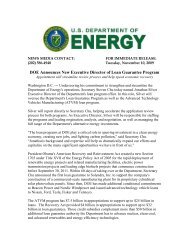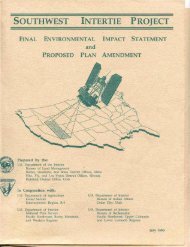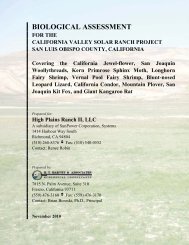Bureau of Land Management's Decision Record and Environmental
Bureau of Land Management's Decision Record and Environmental
Bureau of Land Management's Decision Record and Environmental
Create successful ePaper yourself
Turn your PDF publications into a flip-book with our unique Google optimized e-Paper software.
Jersey Valley Geothermal Development Project<br />
<strong>Environmental</strong> Assessment: NV063-EAO8-091<br />
entity with a field visit having been conducted on June 4, 2009. Recent communications with<br />
tribal leadership has resulted in another field tour request by the Battle Mountain B<strong>and</strong><br />
Chairman. Arrangements are forthcoming.<br />
3.4.2 <strong>Environmental</strong> Consequences<br />
3.4.2.1 Proposed Action<br />
Concerns <strong>and</strong> discussion topics raised to date include impacts to identified cultural resources<br />
within the proposed Project Area, <strong>and</strong> also impacts to hot springs.<br />
• BLM law enforcement monitoring significant sites especially Jersey Valley hot springs;<br />
• Eliminating impacts to wildlife during heavy construction periods especially near water<br />
sources <strong>and</strong> allowing access to water sources up the canyons above the Project Area;<br />
• Responsibility for road maintenance <strong>and</strong> improvement;<br />
• Tribal monitor/observer opportunities during transmission line, facility <strong>and</strong> pipeline<br />
construction <strong>and</strong> any planned or inadvertent data recovery efforts;<br />
• Maintaining existing access routes (trails <strong>and</strong> roads) <strong>and</strong> not increasing access to formerly<br />
inaccessible locations;<br />
• Ensuring no drawdown <strong>of</strong> hot <strong>and</strong> cold spring sources <strong>and</strong> preventing any continued<br />
degradation <strong>of</strong> local springs; <strong>and</strong><br />
• Undeniable impacts to cold <strong>and</strong> hot water sources as a result <strong>of</strong> previous mining <strong>and</strong><br />
geothermal projects throughout Nevada.<br />
Adopted environmental protection measures <strong>and</strong> mitigations have been proposed which address<br />
these concerns <strong>and</strong> include avoidance <strong>of</strong> all eligible <strong>and</strong> unevaluated cultural resource sites <strong>and</strong><br />
implementation <strong>of</strong> a hydrologic monitoring plan (see Sections 2.1.11, 3.9.2, <strong>and</strong> 3.3.2).<br />
Additionally, geothermal lease stipulations (see Appendix A), direct that adverse impacts to<br />
springs are not allowed.<br />
Vehicles, equipment, <strong>and</strong> personnel used for planning, exploration, construction <strong>and</strong><br />
maintenance purposes can have negative impacts to areas utilized by native peoples <strong>and</strong><br />
associated artifacts as identified in Section 33. Long <strong>and</strong> short term noise <strong>and</strong> visual impacts can<br />
have a detrimental impact to existing cultural/traditional/spiritual activities that may occur in<br />
certain areas. As consistently stated during previous communications, sacred sites such as prayer,<br />
sweat lodge, medicinal/strength gathering, <strong>and</strong> edible/medicinal plant gathering locations must<br />
remain quiet <strong>and</strong> undisturbed <strong>and</strong> a sense <strong>of</strong> reverence maintained.<br />
The physical remains <strong>of</strong> past cultural <strong>and</strong> subsistence practices <strong>and</strong> activities (antelope traps,<br />
points, flakes, stone tools, grinding stones, etc...) are also considered to be extremely important<br />
<strong>and</strong> sacred due to such artifacts having been made by the ancestors <strong>and</strong> considered the evidence<br />
<strong>of</strong> thous<strong>and</strong>s <strong>of</strong> years <strong>of</strong> native inhabitance. Archaeological sites within or in close proximity to<br />
certain project boundaries have been known to experience various levels <strong>of</strong> degradation, thus<br />
eliminating not only the physical evidence <strong>of</strong> native occupation, but also archaeological data,<br />
which can produce a better underst<strong>and</strong>ing <strong>of</strong> past <strong>and</strong> present cultures. Archaeological data along<br />
-41-







